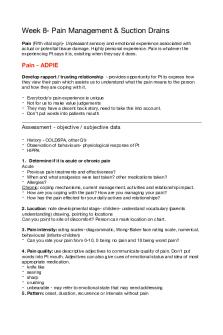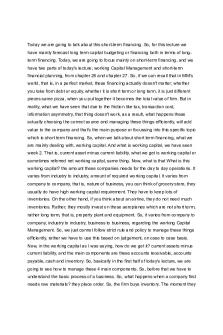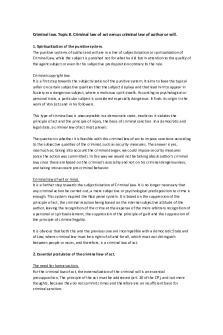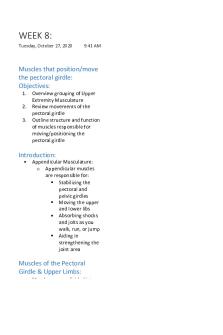8. Hormones and stress - Lecture notes 8 PDF

| Title | 8. Hormones and stress - Lecture notes 8 |
|---|---|
| Course | Psychobiology |
| Institution | University of Sussex |
| Pages | 3 |
| File Size | 214.8 KB |
| File Type | |
| Total Downloads | 301 |
| Total Views | 513 |
Summary
8. Hormones and stressStress:A physical mental or emotional strain or tensionOperationally defined as something that leads to a measurable stress response - Release of stress related hormones or physiological stress responses (ex: changes in heart rate, skin conductance (sweating) etc )Hypothalamo-p...
Description
8. Hormones and stress Stress: A physical mental or emotional strain or tension Operationally defined as something that leads to a measurable stress response -
Release of stress related hormones or physiological stress responses (ex: changes in heart rate, skin conductance (sweating) etc )
Hypothalamo-pituitary axis (HPA) CRH is released in the pituitary stalk Components of the physiological/ hormonal response to stress -
CRH- corticotropin releasing hormone, a small peptide hormone
-
ACTH- another larger peptide hormone
-
Adrenalin and Noradrenalin- both monoamines
-
Glucocorticoids e.g. corsol (primates)- a steroid -
-
(other examples of steroids include testosterone and oestrogen)
It is the effect of monoamines and glucocorticoids that lead to many of the adaptive physiological res to the stress
-
All of these molecules act via protein receptors in the target tissue -
the relevant monoamine receptors are the adrenergic α (‘alpha’) and β (‘beta’) receptors
Hormones, neurotransmitters and receptors - Diagram 1 shows the standard mechanism in which binding to a cell surface receptor stimulates intrace production of a second messenger - Diagram 2 shows steroids directly penetrating the cell membrane (fat soluble) and acting on intracellula receptors. They also interact with cell surface receptors
Stress The faster neutrally mediated response -
The stressor activates brain circuits, including amygdala, hypothalamus and brainstem, then via sympathetic neurons that directly innervate the adrenal medulla.
-
These monoamines lead to mobilisation of metabolic resources together with shifts in blood circulation to facilitate vigorous activity.
-
sympathetic nervous system acve, adrenaline and noradrenaline released -
-
fight or flight
parasympathetic nervous system acve, acetylcholine released -
‘rest and digest
The slower, hormonally mediated response -
The release of cortisol is triggered by ACTH from the pituitary
-
Some of the effects overlap those of the monoamines adrenalin and noradrenalin
-
They also enhance the ability to use fats and proteins in metabolism and a variety of other effects.
-
- Inability to produce glucocorticoids -
(e.g. Addison’s disease)greatly increases vulnerability to stress
Habituation of stress responses -
green – hormonal
-
red – sympathetic
-
blue – parasympathetic
In graphs, -
yellow - baseline,
-
Orange - during the jump
-
Purple - after-
Note the inverse relationship between corso land testosterone secretion and thathabituaon of response is considerable after 2-5 jumps have been made.
Stress responses to painful stimuli -
Acute stressors (including painful stimuli)induce an ‘analgesic’ e3ect that involves suppression of inc ‘nociceptive’ information.
-
This process involves the release of endogenous opioid peptides and monoamines, among other neurochemical mechanisms
-
Different types of stress activate different mechanisms e.g. a cold water swim and a skin in;ammatory response both evoke an analgesic response but with different underlying neurochemistry
They went on to demonstrate that this e3ect can be reversed by treatment with a CRH receptor antagonis that it is associated with increased levels in the amygdala, a brain region strongly associated with anx and stress.
The effects of chronic stress - Chronic exposure to stressors (days/weeks), especially early in life, may be associated with loss of the usu feedback control by corsol on the production and release of CRH and ACTH. hence cortisol levels rem chronically high.- Long term effects may include changed hippocampal function and structure – assoc with depression and ameliorated by an-depressant drugs in experimental models.- However in other circumstances there may be enhanced feedback, leading to lowered cortisol levels – this is associated chronic fatigue syndrome.
Stress and immune function - There are important interactions between stress responses and immune function. - Glucocorticoid rele leads to suppression of in;amman and immune responses.- Tissue damage leads to increased release o cytokines- Cytokines act at CNS receptors (hypothalamus and elsewhere) to produce behavioural e3ec (feelings of illness and lethargy). - These responses may promote withdrawal from a dangerous environ rest and recovery, and hence enhance biological fitness
Individual differences in stress - This is a speculative hypothesis (‘worriers vs warriors’ – Stein et al 2006) but does illustrate that gene variants may predispose to individual variation that is adaptive under different circumstances- The enzyme catechol-O-methyltransferase (COMT) is important in degrading dopamine.There are two common gene variants in human populations (‘Met’ or ‘Val’) which in;uence enzyme activity (homozygous for Met → lower COMT activity → higher dopamine levels).Dopamine levels play an important role in regulating activity in CSTC loops.- Individuals with the Met (↑ DA) genotype may deal more easily with demanding cognitive tasks, but may also be prone to greater stress responses and a tendency to worry.- Individuals with the Val genot DA) may be less disabled by stress and worry, but require greater activation in CSTC loops during demanding cognitive tasks, potentially leading to a greater vulnerability to psychosis.
The stress cascade - You might like to think of stressors assigning a cascade of physiological events over me. These are initi beneficial but potentially become more harmful with long term or chronic stressors. Gene variants ma modify the balance between beneficial and harmful effects....
Similar Free PDFs

Stress lec - Lecture notes 8
- 8 Pages

8 - Lecture notes 8
- 21 Pages

8 - Lecture notes 8
- 21 Pages

8 Midwifery - Lecture notes 8
- 3 Pages

Taxation 8 - Lecture notes 8
- 2 Pages

Week 8 - Lecture notes 8
- 6 Pages

Dox 8 - Lecture notes 8
- 21 Pages

Lesson 8 - Lecture notes 8
- 2 Pages

Assignment 8 - Lecture notes 8
- 4 Pages

Week 8 - Lecture notes 8
- 23 Pages

WEEK 8 - Lecture notes 8
- 10 Pages

CL-8 - Lecture notes 8
- 12 Pages

Tema 8 - Lecture notes 8
- 8 Pages

Lesson 8 - Lecture notes 8
- 19 Pages

Chapter 8 - Lecture notes 8
- 7 Pages
Popular Institutions
- Tinajero National High School - Annex
- Politeknik Caltex Riau
- Yokohama City University
- SGT University
- University of Al-Qadisiyah
- Divine Word College of Vigan
- Techniek College Rotterdam
- Universidade de Santiago
- Universiti Teknologi MARA Cawangan Johor Kampus Pasir Gudang
- Poltekkes Kemenkes Yogyakarta
- Baguio City National High School
- Colegio san marcos
- preparatoria uno
- Centro de Bachillerato Tecnológico Industrial y de Servicios No. 107
- Dalian Maritime University
- Quang Trung Secondary School
- Colegio Tecnológico en Informática
- Corporación Regional de Educación Superior
- Grupo CEDVA
- Dar Al Uloom University
- Centro de Estudios Preuniversitarios de la Universidad Nacional de Ingeniería
- 上智大学
- Aakash International School, Nuna Majara
- San Felipe Neri Catholic School
- Kang Chiao International School - New Taipei City
- Misamis Occidental National High School
- Institución Educativa Escuela Normal Juan Ladrilleros
- Kolehiyo ng Pantukan
- Batanes State College
- Instituto Continental
- Sekolah Menengah Kejuruan Kesehatan Kaltara (Tarakan)
- Colegio de La Inmaculada Concepcion - Cebu
